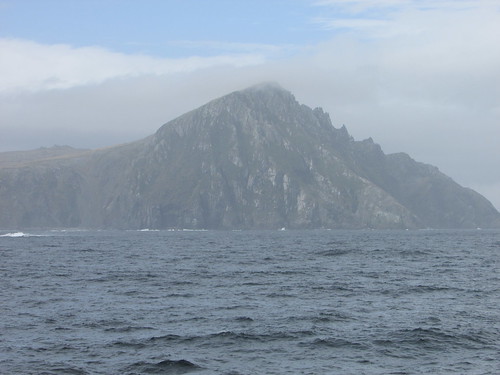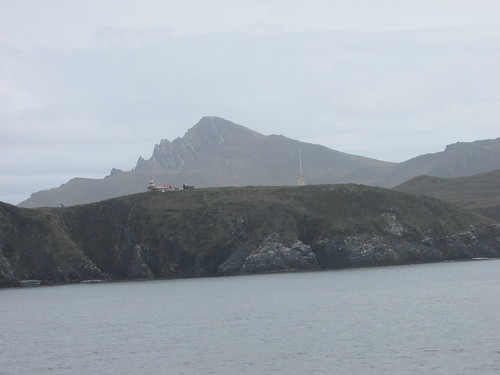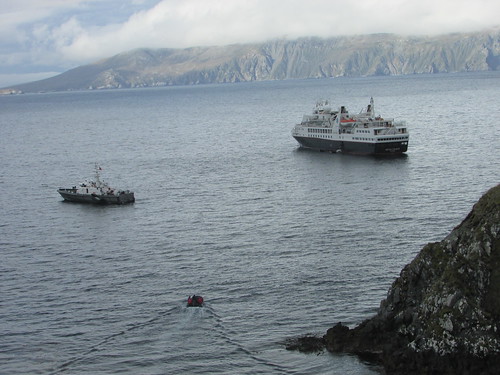Events of Wednesday, 23rd November
The previous evening, Kara, the Expedition Team Leader, had announced that we were to take an alternate channel through the islands of Terra del Fuego which should save time, allowing a closer look at Cape Horn, which the Chilean Navy had approved.
Our first few days travelling south from Valparaiso had enjoyed good weather and this had continued overnight. On Wednesday morning Kara announced that, with a following wind, we had made good time overnight. As we continued our transit to Cape Horn, I was able to spend some time outside on the open deck without the need to wrap up.
IAATO Briefing
At ten o’clock there was a mandatory IAATO Briefing in the theatre. The International Association of Antarctica Tour Operators (IAATO) was set up by the industry to regulate tourism in Antarctica so as to comply with the objectives of the multi-governmental Antarctic Treaty System which has developed from the original Antarctic Treaty of 1959 designating Antarctica as “a zone of peace and science”. The briefing outlined guests’ roles in:-
Protecting Antarctic wildlifeIAATO has a website here.
Respecting protected areas
Respecting scientific research
Remaining safe
Keeping Antarctica pristine
Learning about Whales
A feature of the Silversea Cruises is the regular lectures by members of the Expedition Team. At 11:15, Luke’s lecture on whales and identifying species was warmly received and was followed by many questions from the audience
. Approaching Cape Horn
The afternoon lecture by Peter on the little-known Polar explorer Charcot was postponed as we approached the impressive bulk of Cape Horn. The decision to divert to Cape Horn had introduced a complication: We’d had two Chilean Pilots on board since leaving Valparaiso and I think the original plan called for us to release the pilots at a small port to the north of Cape Horn. The small manned station actually at Cape Horn, we discovered, is serviced by the Chilean Navy and the revised plan called for us to ‘drop’ the Pilots at this station, from where the Navy would transfer them to an airport for an internal flight back north.

Approaching Cape Horn.
So we ‘Rounded the Horn’ and could then see the lighthouse on the next headland where the manned station is located. As we came closer, the ‘Albatross Memorial’ could be seen near to the station. Of course, all of this was very unfamiliar to most passengers (and, indeed, most of the Expedition Team).

Cape Horn Station.
The plan was to put the Pilots ashore by Zodiac and assess whether it would be safe for the guests to make a landing. As we anchored a few hundred yards from the steep cliffs, we could see a tiny, boulder-strewn beach with a daunting-looking set of wooden steps zig-zagging up the cliff face. Our survey Zodiac reported favourably so those wishing to go ashore dressed warmly for a ‘wet landing’. Since the landing groups rotate, on this occasion I was in one of the last Zodiac groups.

Cape Horn: The landing place, steps, funicular and (left background) the Albatross Memorial.
Our Zodiac driver went bow to the shore, with two members of the Expedition Team holding on to the Zodiac whilst passengers clambered over the side of the boat into a foot or so of water. The first couple of yards over large, round stones was tricky, but help was at hand from the Expedition Team members. Then it was onto well-constructed wooden stairs with a handrail – a stiff climb but with wonderful views from the top. I was surprised to find a working funicular railway provided to carry stores from the landing site to the top of the cliff. There was a modern brick building, with a huge Chilean flag facing the sea which housed the electric motor and winch for the funicular railway. Nearby was a fuel tank and a helicopter landing pad. A long boardwalk with some steps led to the lighthouse building with a modern extension serving as office, visitor centre and accommodation for the family in residence. Just outside was a small, rustic wooden church. Another boardwalk with steps led to the ‘Albatross Memorial’ which commemorates all sailors who lost their lives near Cape Horn.
A Navy launch arrived and anchored near our ship to collect our two Chilean Pilots and one man from the Cape Horn station. The Captain of the launch and three of his men took the opportunity presented by their unusual assignment to come ashore and take pictures. The Naval Captain chatted to us in excellent English. We had plenty of time to enjoy this very special visit before returning to the ship.

View from Cape Horn station. L: Navy Launch, R: 'Silver Explorer'. In the foreground, a Zodiac is returning passengers to the ship.
With everyone back on board, we set off on our long crossing of the Drake Passage which would take the rest of Wednesday, all of Thursday, making landfall at the South Shetland Islands sometime Friday morning.
Related Posts
Next post describing this trip: The Drake Passage.
All posts describing this trip: Chilean Fjords.
My pictures
Where necessary, clicking on an image above will display an 'uncropped' view or, alternately, my pictures from this (and earlier) trips may be selected, viewed or downloaded, in various sizes, from the album listed:-
Cape Horn.
All my pictures of Chile can be found in the collection Chile.
[Links to pictures added, pictures added: 26-Jan-2017]
